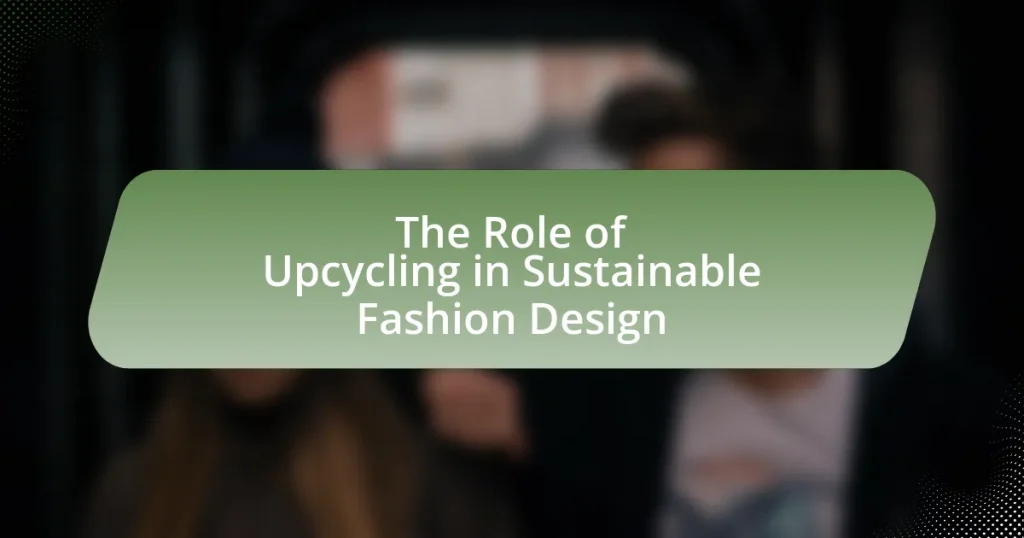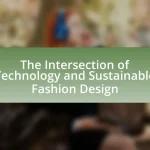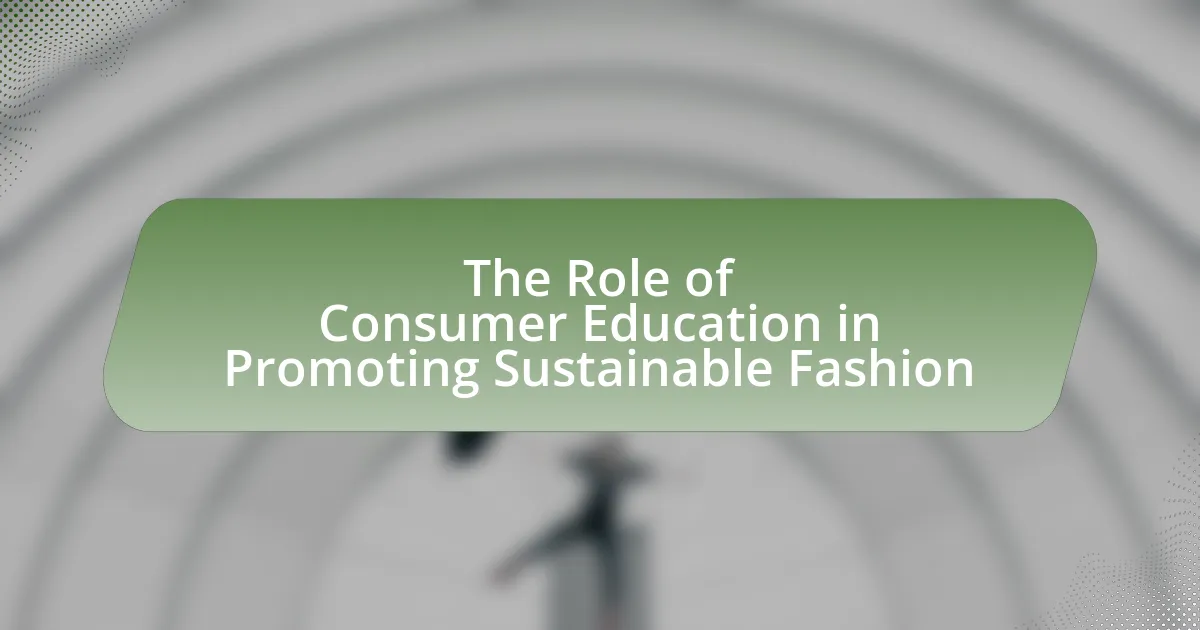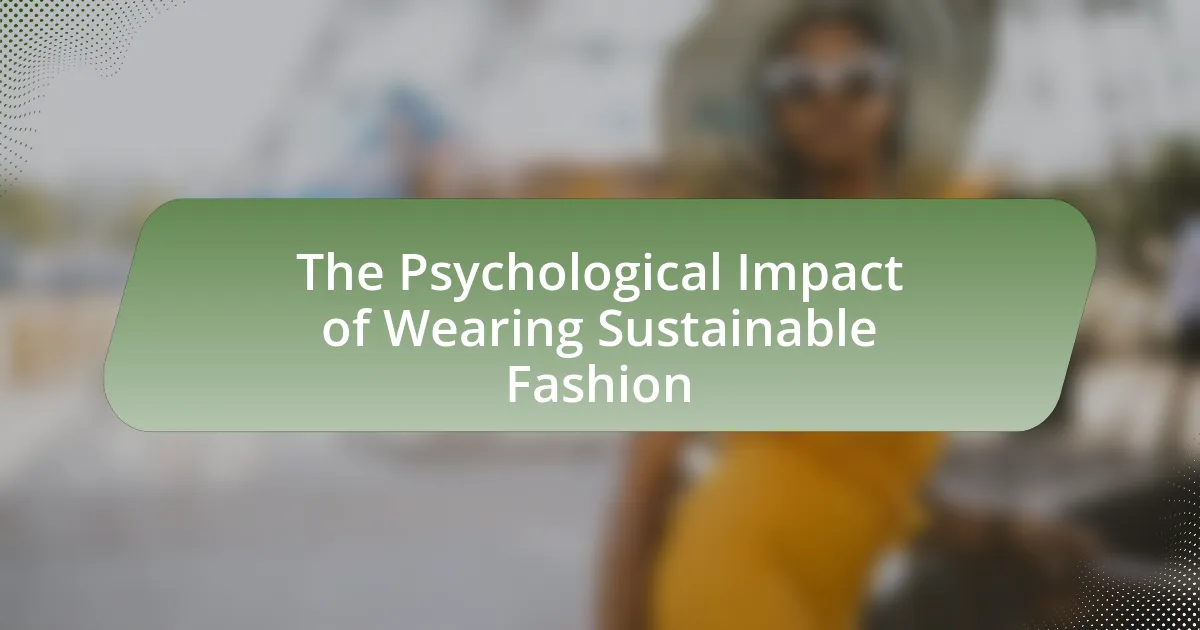Upcycling is a pivotal practice in sustainable fashion design, focusing on the transformation of waste materials into new products to mitigate environmental impact. This article explores how upcycling reduces textile waste, conserves resources, and promotes a circular economy, addressing the fashion industry’s significant contribution to global waste. It examines the materials commonly upcycled, the processes involved, and the challenges designers face, while highlighting the economic advantages and market opportunities that arise from upcycled fashion. Additionally, the article discusses the role of consumer awareness in driving demand for sustainable practices and the unique styles that emerge from upcycled designs, emphasizing the importance of creativity and individuality in the future of fashion.
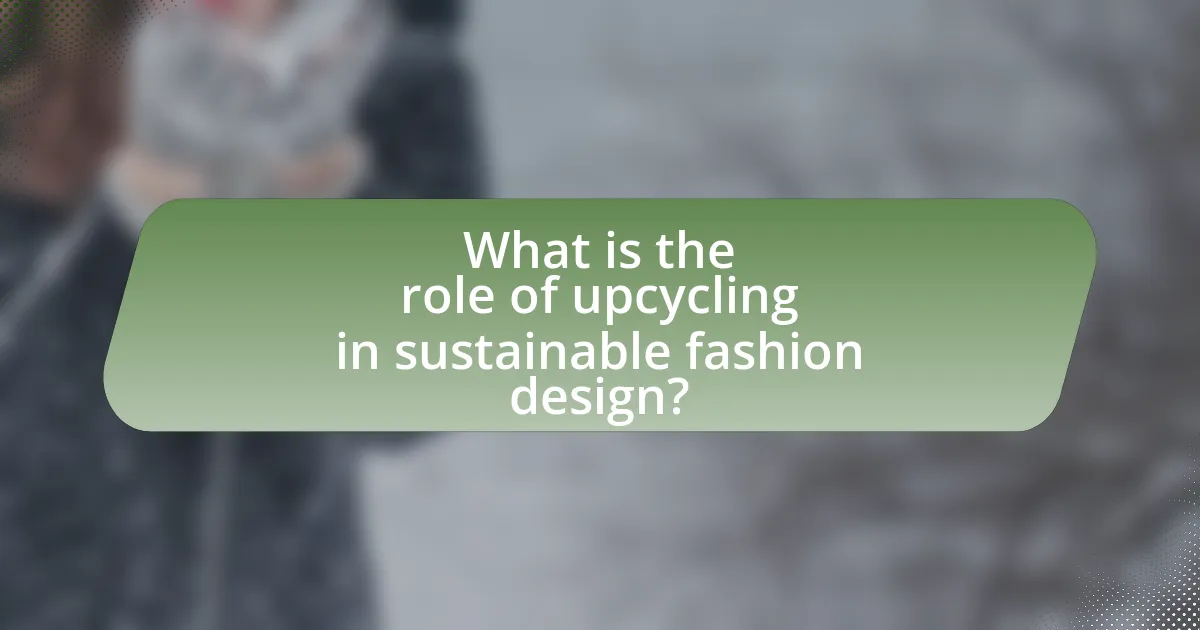
What is the role of upcycling in sustainable fashion design?
Upcycling plays a crucial role in sustainable fashion design by transforming waste materials into new products, thereby reducing environmental impact. This practice minimizes textile waste, as approximately 92 million tons of textile waste are generated globally each year, according to the Ellen MacArthur Foundation. By creatively repurposing discarded fabrics and garments, upcycling not only conserves resources but also promotes a circular economy, where materials are reused rather than disposed of. Furthermore, upcycling encourages innovation and individuality in fashion, allowing designers to create unique pieces that challenge fast fashion norms.
How does upcycling contribute to sustainability in fashion?
Upcycling contributes to sustainability in fashion by transforming waste materials into new products, thereby reducing the demand for virgin resources. This process minimizes textile waste, as it repurposes discarded clothing and materials that would otherwise end up in landfills. According to a report by the Ellen MacArthur Foundation, the fashion industry is responsible for 92 million tons of waste annually, highlighting the significant impact of upcycling in mitigating this issue. By extending the lifecycle of materials, upcycling not only conserves resources but also lowers carbon emissions associated with production and disposal, making it a crucial practice for sustainable fashion.
What materials are commonly upcycled in fashion design?
Commonly upcycled materials in fashion design include textiles such as denim, cotton, and wool, as well as non-textile items like plastic bottles and leather scraps. Denim is frequently repurposed due to its durability and widespread availability, while cotton and wool are often sourced from discarded garments. Additionally, plastic bottles can be transformed into fibers for new clothing, and leather scraps can be creatively reused to minimize waste. This practice not only reduces landfill contributions but also promotes sustainable fashion by extending the lifecycle of materials.
How does upcycling reduce waste in the fashion industry?
Upcycling reduces waste in the fashion industry by transforming discarded materials into new products, thereby diverting textiles from landfills. This process not only minimizes the volume of waste generated but also reduces the demand for new raw materials, which often involves resource-intensive production methods. According to the Ellen MacArthur Foundation, the fashion industry is responsible for 92 million tons of waste annually, and upcycling can significantly mitigate this impact by extending the lifecycle of existing materials. By creatively reusing fabrics and garments, upcycling fosters a circular economy, promoting sustainability and reducing the overall environmental footprint of fashion.
Why is upcycling important for the future of fashion?
Upcycling is important for the future of fashion because it significantly reduces waste and promotes sustainability. The fashion industry is one of the largest polluters globally, with an estimated 92 million tons of textile waste generated each year. By transforming discarded materials into new products, upcycling minimizes the need for virgin resources and decreases landfill contributions. Furthermore, upcycling fosters creativity and innovation within the industry, encouraging designers to explore alternative materials and methods. This shift not only aligns with consumer demand for sustainable practices but also supports a circular economy, where products are reused and repurposed rather than discarded.
What are the environmental impacts of traditional fashion versus upcycled fashion?
Traditional fashion has significant environmental impacts, including high water consumption, pollution from dyes and chemicals, and substantial textile waste. For instance, the fashion industry is responsible for approximately 20% of global wastewater and emits more greenhouse gases than international flights and maritime shipping combined. In contrast, upcycled fashion reduces these impacts by repurposing existing materials, thereby minimizing waste and resource consumption. Upcycling can decrease water usage by up to 90% compared to traditional manufacturing processes, as it often requires no new raw materials. This approach not only diverts textiles from landfills but also lowers the carbon footprint associated with producing new garments.
How does consumer awareness influence the role of upcycling?
Consumer awareness significantly enhances the role of upcycling by driving demand for sustainable practices in fashion. As consumers become more informed about environmental issues and the negative impacts of fast fashion, they increasingly seek out brands that prioritize sustainability, including those that incorporate upcycling into their production processes. Research indicates that 66% of global consumers are willing to pay more for sustainable brands, demonstrating a clear market shift towards eco-friendly practices. This heightened awareness not only encourages brands to adopt upcycling as a viable business model but also fosters a culture of sustainability, where consumers actively support and promote upcycled products.
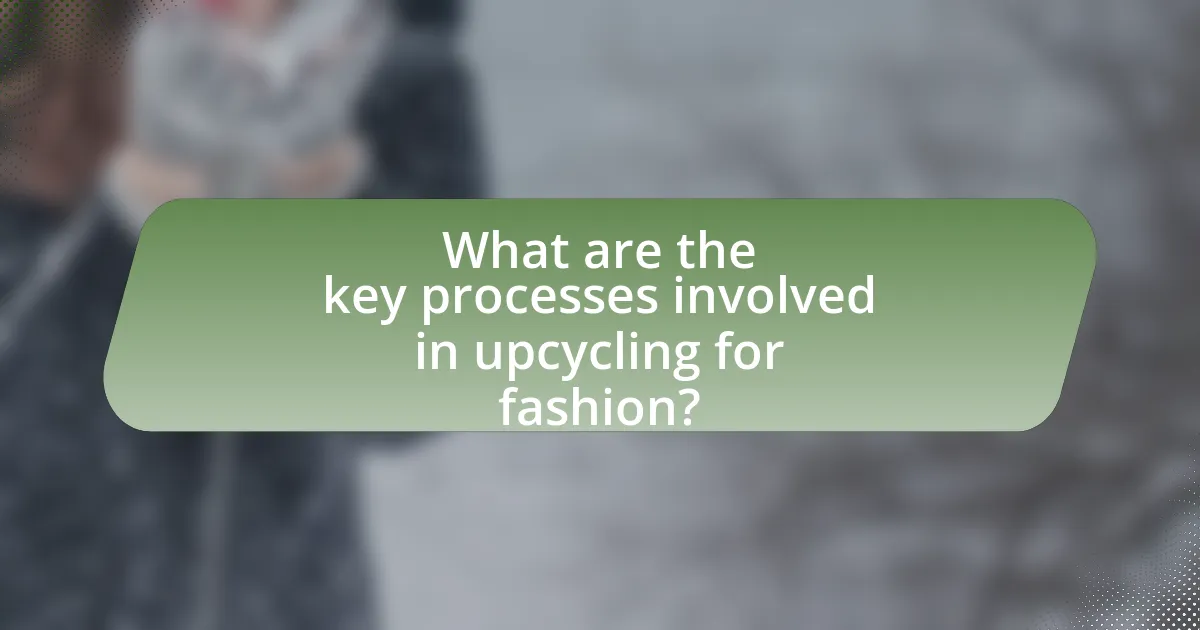
What are the key processes involved in upcycling for fashion?
The key processes involved in upcycling for fashion include collection, design, transformation, and marketing. Collection involves sourcing discarded materials or garments that can be repurposed, often from thrift stores or waste streams. Design focuses on reimagining these materials into new fashion items, emphasizing creativity and innovation. Transformation is the physical process of altering the collected materials, which may include sewing, dyeing, or embellishing to create a finished product. Finally, marketing entails promoting the upcycled fashion items, highlighting their sustainability and unique story to attract consumers. These processes collectively contribute to reducing waste and promoting sustainable practices in the fashion industry.
How do designers approach the upcycling process?
Designers approach the upcycling process by creatively transforming waste materials or discarded products into new, functional items. This method emphasizes innovation and sustainability, as designers often analyze the potential of materials that would otherwise contribute to landfill waste. For instance, a study published in the Journal of Fashion Technology & Textile Engineering highlights that upcycling can reduce the environmental impact of fashion by minimizing resource consumption and waste generation. By reimagining existing materials, designers not only contribute to sustainability but also create unique, one-of-a-kind pieces that reflect individual creativity and environmental consciousness.
What techniques are used in upcycling garments?
Techniques used in upcycling garments include patchwork, embroidery, dyeing, and reconstruction. Patchwork involves sewing together pieces of fabric from old garments to create new designs, enhancing both aesthetics and functionality. Embroidery adds decorative elements to existing clothing, transforming simple items into unique pieces. Dyeing techniques, such as tie-dye or natural dyeing, allow for color changes and pattern creation, revitalizing faded fabrics. Reconstruction entails altering the structure of a garment, such as changing its silhouette or combining multiple items into one, which promotes creativity and reduces waste. These methods contribute to sustainable fashion by extending the life cycle of textiles and minimizing landfill contributions.
How do designers source materials for upcycling?
Designers source materials for upcycling primarily through the collection of discarded items, surplus stock, and second-hand goods. They often visit thrift stores, flea markets, and recycling centers to find materials that can be repurposed into new designs. Additionally, some designers collaborate with local businesses to obtain waste materials, such as fabric scraps or unsold inventory, which can be transformed into unique fashion pieces. This practice not only reduces waste but also promotes sustainability in the fashion industry by giving new life to materials that would otherwise contribute to landfill overflow.
What challenges do designers face in upcycling?
Designers face several challenges in upcycling, primarily related to material sourcing, design constraints, and consumer perception. Material sourcing can be difficult as designers often rely on discarded items that may not be readily available or may vary in quality and type, making it challenging to create cohesive collections. Design constraints arise from the unpredictable nature of upcycled materials, which can limit creative possibilities and require innovative problem-solving to ensure functionality and aesthetics. Additionally, consumer perception poses a challenge; many consumers may associate upcycled products with lower quality or may not fully understand the value of sustainable practices, impacting market demand. These challenges highlight the complexities designers navigate in promoting upcycling as a viable and attractive option in sustainable fashion.
How can designers overcome limitations in material availability?
Designers can overcome limitations in material availability by utilizing upcycling techniques to repurpose existing materials into new products. This approach not only addresses scarcity but also promotes sustainability by reducing waste. For instance, a study by the Ellen MacArthur Foundation highlights that upcycling can significantly decrease the demand for virgin materials, thereby conserving resources and minimizing environmental impact. By creatively transforming discarded textiles and other materials, designers can innovate while adhering to sustainable practices.
What are the common misconceptions about upcycling in fashion?
Common misconceptions about upcycling in fashion include the belief that it is only about reusing materials without any design consideration and that upcycled items are of lower quality. In reality, upcycling involves creative design processes that enhance the value of materials, transforming them into unique, high-quality products. For instance, a study by the Ellen MacArthur Foundation highlights that upcycling can significantly reduce waste and resource consumption, demonstrating its potential for sustainable fashion. Additionally, many high-end brands now incorporate upcycled materials into their collections, proving that upcycled fashion can be both stylish and durable.
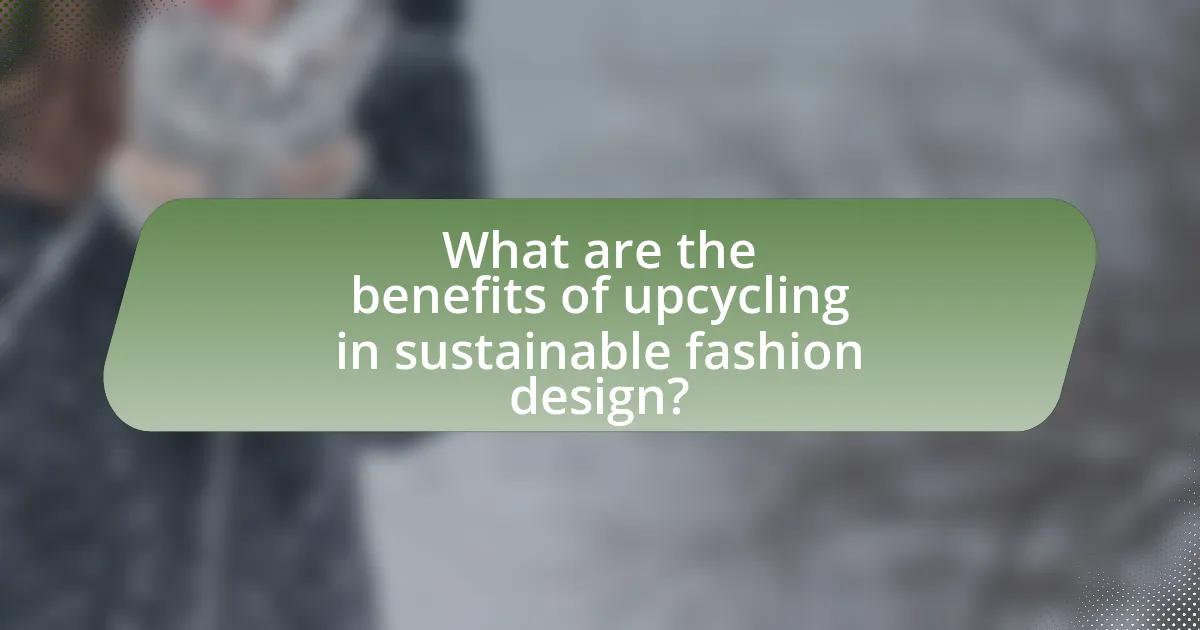
What are the benefits of upcycling in sustainable fashion design?
Upcycling in sustainable fashion design significantly reduces waste and promotes resource efficiency. By transforming discarded materials into new products, upcycling minimizes the environmental impact associated with textile production, which is responsible for approximately 10% of global carbon emissions. Additionally, upcycling fosters creativity and innovation, allowing designers to create unique pieces that stand out in a saturated market. This practice also supports local economies by encouraging small-scale production and craftsmanship, which can lead to job creation. Furthermore, upcycling raises consumer awareness about sustainability, encouraging more responsible purchasing behaviors.
How does upcycling enhance creativity in fashion design?
Upcycling enhances creativity in fashion design by encouraging designers to reimagine and repurpose existing materials, leading to innovative and unique creations. This practice allows designers to break free from conventional design constraints, as they must think critically about how to transform discarded items into fashionable pieces. For instance, a study by the University of Cambridge found that upcycling fosters problem-solving skills and promotes originality, as designers explore new techniques and aesthetics. By utilizing materials that would otherwise contribute to waste, upcycling not only inspires creativity but also aligns with sustainable practices in the fashion industry.
What unique styles emerge from upcycled fashion?
Unique styles that emerge from upcycled fashion include patchwork designs, mixed-media garments, and one-of-a-kind accessories. Patchwork designs often combine various fabric scraps, creating visually striking pieces that tell a story of their previous life. Mixed-media garments incorporate different materials, such as denim with lace or leather with cotton, resulting in innovative textures and aesthetics. One-of-a-kind accessories, like bags made from repurposed materials, showcase individuality and creativity, appealing to consumers seeking unique fashion statements. These styles not only promote sustainability but also encourage creativity and personal expression in fashion.
How does upcycling promote individuality in clothing?
Upcycling promotes individuality in clothing by transforming discarded materials into unique fashion pieces that reflect personal style. This process allows designers and consumers to create one-of-a-kind garments, as each upcycled item carries distinct characteristics based on its original form and the creative alterations made. For instance, a study published in the Journal of Fashion Marketing and Management highlights that upcycled clothing often features unconventional designs and textures, which contribute to a personalized aesthetic that mass-produced items cannot offer. Thus, upcycling not only reduces waste but also fosters self-expression through distinctive fashion choices.
What economic advantages does upcycling offer to designers?
Upcycling offers designers significant economic advantages by reducing material costs and creating unique products that can command higher prices. By utilizing discarded materials, designers minimize the need for new raw materials, which lowers production expenses. Additionally, upcycled items often attract consumers seeking sustainable options, allowing designers to differentiate their products in a competitive market. This differentiation can lead to increased sales and brand loyalty, as evidenced by a report from the Ellen MacArthur Foundation, which highlights that the circular economy, including upcycling, can generate substantial economic benefits by reducing waste and fostering innovation in product design.
How can upcycling reduce production costs for fashion brands?
Upcycling can reduce production costs for fashion brands by utilizing existing materials, which decreases the need for new raw materials and associated manufacturing expenses. By repurposing discarded textiles and garments, brands can significantly lower their material costs, as they often acquire these items at little to no cost. For instance, a study by the Ellen MacArthur Foundation highlights that upcycling can lead to a reduction in material costs by up to 50%, as brands leverage surplus inventory and waste instead of sourcing new fabrics. This approach not only minimizes expenses but also aligns with sustainable practices, enhancing brand reputation and potentially attracting eco-conscious consumers.
What market opportunities arise from upcycled fashion products?
Market opportunities arising from upcycled fashion products include increased consumer demand for sustainable options, potential for premium pricing, and the ability to tap into niche markets focused on eco-consciousness. The rise in consumer awareness regarding environmental issues has led to a significant shift towards sustainable fashion, with a report by McKinsey & Company indicating that 67% of consumers consider the use of sustainable materials important when making a purchase. Additionally, upcycled products often command higher prices due to their unique nature and the craftsmanship involved, allowing brands to enhance their profit margins. Furthermore, upcycled fashion can cater to niche markets, such as those interested in vintage aesthetics or personalized items, thereby expanding a brand’s customer base and market reach.
What practical tips can designers follow to implement upcycling effectively?
Designers can implement upcycling effectively by sourcing materials from discarded items, which reduces waste and promotes sustainability. Utilizing local thrift stores or fabric recycling centers allows designers to find unique materials that can be transformed into new products. Additionally, incorporating modular design principles enables easy disassembly and reassembly of garments, facilitating future upcycling. Designers should also engage in community workshops to educate others about upcycling techniques, fostering a culture of sustainability. Research indicates that upcycling can significantly reduce the environmental impact of fashion, with studies showing that reusing materials can cut carbon emissions by up to 80%.
